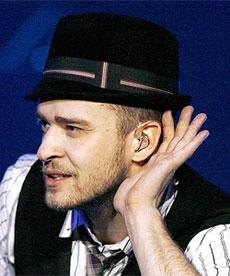
Retro fedora hats, like the kind favoured by pop star Justin Timberlake, are helping bring sexy back.[Reuters]
Entering the Borsalino hat factory, high altar for headwear worshippers, is like stepping into a time warp.
Wood-encased machinery from the 19th century cranks out fluffy sheets of beaver and rabbit felt and workers use antique wooden forms to shape crowns the same way their predecessors did for headgear that has graced Hollywood stars, kings and popes.
A favourite of 1920s Chicago gangster Al Capone and Japanese Emperor Hirohito, Borsalinos have remained the gold standard for luxury hats for 150 years through war, corporate buy-outs and the collapse of their market.
Now resurging from decades of postwar hatless fashion, Borsalino sees no reason to change.
"Some of the steps we do have to be done the same way we did it 50, 60, 70 years ago," said sales director Claudio Mennuni.
"We found we couldn't get the same quality using new gear," like lighter irons to shape brims instead of old gas-fired heavyweights, he said. "In a lot of cases you have to fix the equipment, you can't find it anywhere else."
OLD HAT TECHNIQUES
Relying on old techniques has worked for Borsalino, which has made hats for people ranging from emperors and Sephardic Jews to Canadian Mounties.
Screen stars from Humphrey Bogart in Casablanca to Denzel Washington's dapper detective in last year's Inside Man have topped off with Borsalino's signature trilbies, or fedoras.
In some parts of Italy the word was synonymous for "hat", and Borsalino offices carried a warning sign: "Those not wearing a hat are not welcome."
With its felt hats costing 200 euros to more than double that for those made with exotic guanaco wool, "it is probably the highest-quality premium brand in the world", said Carol Denford, fashion editor at Britain's Hat Magazine.
"It's the ultimate trilby, the ultimate hat."
Founded in 1857 by French-trained Giuseppe Borsalino, the company saw its best years in the 1920s, when output peaked at 2 million hats a year.
But in World War Two, allied bombs flattened Borsalino's factories, and then the lifestyle revolution of the 1960s and the growing use of cars, which protected men's heads from weather, sent sales into a tailspin.
Borsalino's heirs sold the company in the 1980s and, as the company moved to a new site in 1986, production plunged. A group run by the Gallo and Monticone families bought it in 1993.
Now Borsalino is staging a comeback, particularly with hats aimed at the under-35s, featuring new fibres, colours and hats that can be folded up and still keep their shape.
TOPPING OFF
These days, fashion-watchers note a trend of nostalgia for the styles of the 1930s and 40s, which include pin-striped suits, overcoats and elegant accessories.
Interest in fedoras and porkpie hats among younger customers has been fuelled by celebrities as pop stars Justin Timberlake, Sean 'P Diddy' Combs and the Black Eyed Peas.
"Beyond the suit, the overcoat, there is particular attention being paid to details, to the belt, the shoes, things like that," Mennuni said. "Hats are taking on their place as a fashion statement."
Borsalino's revenues hit 20 million euros in 2005 and have grown about 10 percent a year since 2002. Sales have been boosted by stand-alone stores, the launch of women's hats and a clothing line.
Output, which includes Montecristi Panama straw hats and baseball-style caps, is now about 250,000 pieces a year.
The company has about 400 workers, half at a plant in China that produces hats for other labels.
Giovanna Usuelli Borsalino, the 92-year-old widow of the family's last heir, strolled through a museum at the company's old headquarters, which features rows of top hats in raspberry, pink and sky blue and lustrous bowlers for Andean highlanders.
"These are wonderful hats they make today, because Borsalino is still alive," she said.





